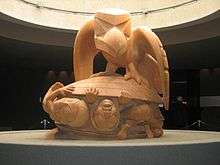Haida mythology
The Haida are one of the indigenous peoples of the Pacific Northwest Coast of North America. Their national territories lie along the west coast of Canada and include parts of south east Alaska.
Raven

Within Haida mythology, Raven is a central character, as he is for many of the Indigenous peoples of the Americas, see Raven Tales. While frequently described as a "trickster", Haidas believe Raven or Yáahl[1] to be a complex reflection of one's own self. Raven can be a magician, a transformer, a potent creative force, ravenous debaucher but always a cultural hero. He is responsible for creating Haida Gwaii, releasing the sun from its tiny box and making the stars and the moon. In one story he released the first humans from a cockle shell on the beach; in another story he brought the first humans up out of the ground because he needed to fill up a party he was throwing. Raven stories on one level teach listeners how to live a good life, but usually by counterexample. Raven has been described as the greediest, most lecherous and mischievous creature known to the Haida, but at the same time Raven often helps humans in our encounters with other supernatural beings. Raven acquired such things as fresh water, salmon and the house for humans. Robert Bringhurst has noted that Raven never actually creates anything; he made the world by stealing, exchanging, redistributing, and generally moving things around.
Other figures
Ta'xet and Tia are death gods among the Haida. Ta'xet rules violent death, while Tia rules peaceful death. Dzalarhons, a woman associated with frogs and volcanoes, and her husband, Kaiti (bear god), arrived at the homeland of the Haida from the Pacific Ocean along with six canoes full of people. Gyhldeptis is a kindly forest goddess. Lagua is an invisible spirit who helped the Haida discover the uses of iron. Shamans could speak with Lagua's voice by clenching their teeth. Sin ("day") is the sky god and chief deity.
Some of the mythology has been collected by poet Anne Cameron, who created interpretations for adults and children. Epic versions of the mythology by 19th century Haida storyteller-poets Skaay and Ghandl have been translated by Robert Bringhurst, whose Story as Sharp as a Knife, a collection of their works, won the Governor General's Award. His translations, though, are controversial in Haida circles and some have charged him with cultural appropriation.
References
- Lawrence, Erma (1974). "Yáahl (Xaadas Gyaahláang)". Society for the Preservation of Haida Language and Literature.
External links
- Native Languages of the Americas: Haida Indian Legends, native-languages.org